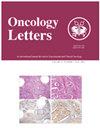Pan‑immune‑inflammation value as a novel prognostic biomarker in nasopharyngeal carcinoma.
IF 2.2
4区 医学
Q3 ONCOLOGY
引用次数: 0
Abstract
The pan-immune-inflammation-value (PIV) is a comprehensive biomarker that integrates different peripheral blood cell subsets. The present study aimed to evaluate the prognostic ability of PIV in patients with nasopharyngeal carcinoma (NPC) undergoing chemoradiotherapy. PIV was assessed using the following equation: (Neutrophil count × platelet count × monocyte count)/lymphocyte count. The Kaplan-Meier method and Cox hazards regression models were used for survival analyses. The optimal cut-off values for PIV and systemic immune-inflammation index (SII) were determined using receiver operating characteristic analysis to be 428.0 and 1032.7, respectively. A total of 319 patients were recruited. Patients with a low baseline PIV (≤428.0) accounted for 69.9% (n=223) and patients with a high baseline PIV (>428.0) accounted for 30.1% (n=96). Compared with patients with low PIV, patients with a high PIV had significantly worse 5-year progression-free survival [PFS; 66.8 vs. 77.1%; hazard ratio (HR), 1.97; 95% confidence interval (CI), 1.22-3.23); P=0.005] and 5-year overall survival (OS; 68.7 vs. 86.9%, HR, 2.71; 95% CI, 1.45-5.03; P=0.001). PIV was also a significant independent prognostic indicator for OS (HR, 2.19; 95% CI, 1.16-4.12; P=0.016) and PFS (HR, 1.86; 95% CI, 1.14-3.04; P=0.013) and outperformed the SII in multivariate analysis. In conclusion, the PIV was a powerful predictor of survival outcomes and outperformed the SII in patients with NPC treated with chemoradiotherapy. Prospective validation of the PIV should be performed to better stratify radical treatment of patients with NPC.作为鼻咽癌新型预后生物标志物的泛免疫炎症值
泛免疫炎症值(PIV)是一种整合了不同外周血细胞亚群的综合生物标志物。本研究旨在评估PIV对接受放化疗的鼻咽癌患者的预后能力。PIV采用以下公式进行评估:(中性粒细胞计数×血小板计数×单核细胞计数)/淋巴细胞计数。生存分析采用 Kaplan-Meier 法和 Cox 危险回归模型。通过接收器操作特征分析确定 PIV 和全身免疫炎症指数(SII)的最佳临界值分别为 428.0 和 1032.7。共招募了 319 名患者。基线 PIV 低(≤428.0)的患者占 69.9%(人数=223),基线 PIV 高(>428.0)的患者占 30.1%(人数=96)。与低PIV患者相比,高PIV患者的5年无进展生存期[PFS;66.8 vs. 77.1%;危险比(HR),1.97;95%置信区间(CI),1.22-3.23;P=0.005]和5年总生存期(OS;68.7 vs. 86.9%,HR,2.71;95% CI,1.45-5.03;P=0.001)明显更差。)PIV也是OS(HR,2.19;95% CI,1.16-4.12;P=0.016)和PFS(HR,1.86;95% CI,1.14-3.04;P=0.013)的重要独立预后指标,在多变量分析中优于SII。总之,在接受化放疗的鼻咽癌患者中,PIV是预测生存结果的有力指标,其表现优于SII。应该对PIV进行前瞻性验证,以便更好地对鼻咽癌患者的根治治疗进行分层。
本文章由计算机程序翻译,如有差异,请以英文原文为准。
求助全文
约1分钟内获得全文
求助全文
来源期刊

Oncology Letters
ONCOLOGY-
CiteScore
5.70
自引率
0.00%
发文量
412
审稿时长
2.0 months
期刊介绍:
Oncology Letters is a monthly, peer-reviewed journal, available in print and online, that focuses on all aspects of clinical oncology, as well as in vitro and in vivo experimental model systems relevant to the mechanisms of disease.
The principal aim of Oncology Letters is to provide the prompt publication of original studies of high quality that pertain to clinical oncology, chemotherapy, oncogenes, carcinogenesis, metastasis, epidemiology and viral oncology in the form of original research, reviews and case reports.
 求助内容:
求助内容: 应助结果提醒方式:
应助结果提醒方式:


